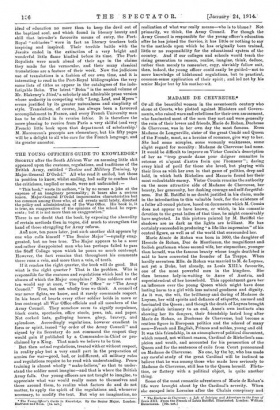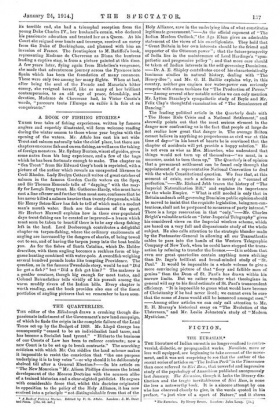MADAME DE CHEVREUSE,
OF all the beautiful women in the seventeenth century who shone at Courts, who plotted against Ministers and Govern- ments, who raised wars and rebellions for their own amusement, who fascinated most of the men they met and were generally the ruin of their lovers and friends, Marie de Rohan, Duchess° de Chevreuae, was in her own day the most famous. Even Madame de Longneville, sister of the great Conde and Queen of the Fronde, must, as a heroine of romance, give way to her. She had some scruples, some womanly weaknesses, some slight regard for morality Madame de Chevreuse had none. It would he difficult to improve on Victor Cousin's description of her as "trap grande dame pour daigner connaitre la retenne et n'ayant d'autre frein que l'honneur "; daring every kind of peril for those she loved, but playing with their lives as with her own in that game of politics, deep and bold, in which both Richelieu and Mazariu found her their most redoubtable enemy. Victor Cousin remains the authority on the more attractive side of Madame de Chevrense, her beauty, her generosity, her dashing courage and self-forgetful- ness. But M. Batiffol is no doubt justified in his claim, made in the introduction to this valuable book, for the existence of a fuller all-round picture, based on documents which M. Cousin does not appear to have known, or which, in his tomantio devotion to the great ladies of that time, he might conceivably have neglected. In this picture painted by M. Batiffol the shadows are as dark as the lights are brilliant. He has certainly succeeded in producing " a life-like impression" of his central figure, as well as of the world that surrounded her.
Marie Aimee de Rohan was born in 1600, the daughter of Hercule de Rohan, Duo de Montbazon, the magnificent and foolish gentleman whose second wife, her stepmother, younger than herself, was the famous beauty whose tragic deathbed is said to have converted the founder of La Trappe. When hardly seventeen Mlle. de Rohan was married to M. de Luynes,
not yet a Duke, but already, as Louis favourite, one of the most powerful men in the kingdom. She then became lady-in-waiting to Anne of Austria, and superintendent of her household. This appointment gave her an influence over the young Queen which might have done lasting berm to a girl with lees natural goodness and dignity. As it was, the wit, the brilliancy and daring of Madame de Luynes, her wild spirits and defiance of etiquette, amused and fascinated the Queen ; and though the death of Lnynea brought their girlish intimacy to an end, Anne's own instincts also showing her its dangers, their friendship lasted long after Marie de Rohan, as Duchesse de Chevreuse, had become a restless figure in European politics and the adored of many men—French and English, Princes and nobles, young and old It was this friendship, in an atmosphere of political discontent, which roused, not without reason, Cardinal de Richelieu's sus- picion and wrath, and accounted for his persecution of the Queen and for the sentences of exile from Court pronounced on Madame de Chevreuse. No one, by the by, who has made any careful study of tile great Cardinal will be inclined to believe that he was among those who made love seriously to Madame de Chevreuse, still less to the Queen herself. Flirta- tion, or flattery with a political object, is quite another thing.
Sonic of the most romantic adventures of Marie de Rollan's life were brought about by the Cardinal's severity. When she escaped into Lorraine after the Chalais conspiracy and
• The Ducheres de Chesnut.: a lofe of intrioue and Adventure in the flop of Loris XIII. From the French of Louts Batiffol. Inuetrated. London: Witham Heinemann. [10s. net.]
its terrible end, she had a triumphal reception from the young Duke Charles IV., her husband's Cousin, who declared his passionate adoration and treated her as a Queen. At his Court she reigned over hunts and tourneys, received an envoy from the Duke of Buckingham, and planned with him an invasion of France. The frontispiece to M. Batiffol's book, representing Madame de Chevrense as Diana the huntress leading a captive stag, is from a picture painted at this time. A few years later, flying again from Richelieu's vengeance, she made that adventurous journey across the Pyrenees into Spain which has been the foundation of many romances. These were only two among her many flights. When at last, after being the soul of the Fronde and Mazarin's bitter enemy, she resigned herself, like so many of her brilliant contemporaries, to an old age of peace, friendship, and devotion, Madame de Chevreuse had, in Victor Cousin's words, "parcouru touts l'Europe en exilee it la foie et en conquerante."







































 Previous page
Previous page